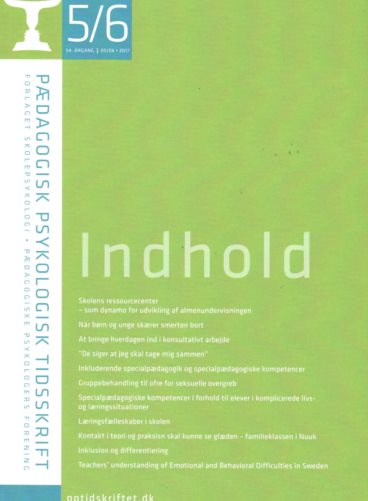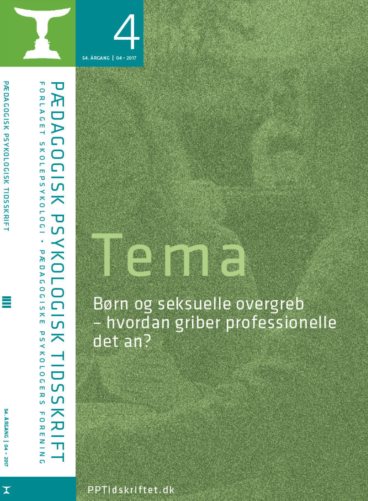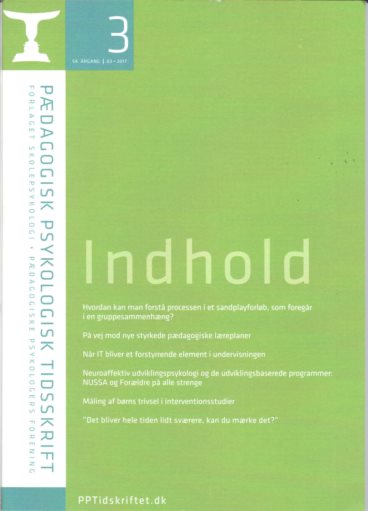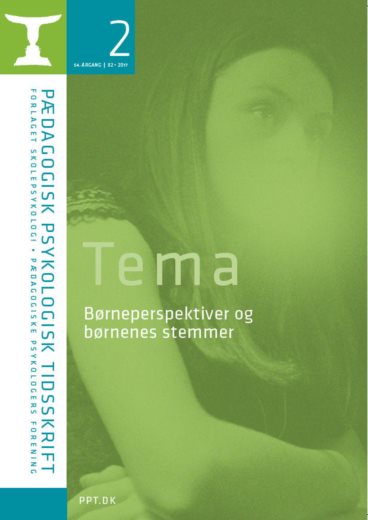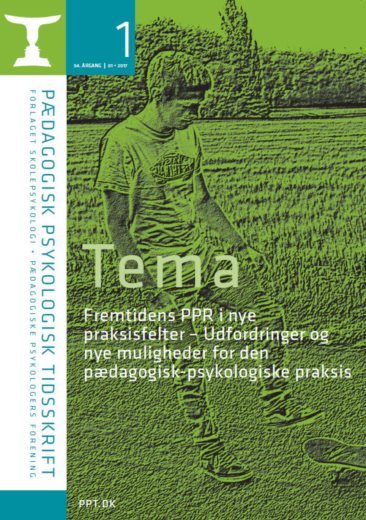Beskrivelse
Bjarne Nielsen: The resource centre of the school. Pædagogisk Psykologisk Tidsskrift, 2017, Vol 55, 5/6, 3-17. The resource centre’s organization and purpose is described as a dynamic system that can handle effective development of the tea-ching and the work of inclusion. The school’s resource centre has very rarely been studied for research and it’s functioning is seldom described in the education legis-lation. The resource centre has many tasks on three different levels – prevention, anticipating and intervention and the article gives several examples from each of the three levels. The key members of the resource centre are the headteacher and the school psychologist from the school psychological services (PPR). Other key members are the coordinating resource teachers in the field of reading and beha-viour problems. Several other professionals are invited when it is relevant – inclu-ding the parents. There are considerations of the reasons of why it is so difficult for the school to maintain and further develop an effective resource centre. It is impor-tant for the school psychological services to work for an effective resource centre at every school in close co-operation with the headteacher.
Bo Møhl & Lotte Rubæk: When children and adolescents cut their pain away. Pædagogisk Psykologisk Tidsskrift, 2017, Vol 55, 5/6, 18-33. The prevalence of non-suicidal self-injury among adolescents has dramatically increased during recent ye-ars. 21% of Danish high school students and 22% of students in 9th grade have a history of non-suicidal self-injury. Self-harm occurs in 93% of schools with 9th gra-de students. It is therefore to be expected that all teachers will at one time meet a self-harming student. This article describes the origins and function of non-suicidal self-injury, and reviews early signs of self-harm and how to evaluate the serious-ness of this action. A guideline of how to respond to students who harm themselves and an outline for an action plan for schools are presented.
Camilla Printz & Mai Juul Andersen: Including the everyday life in consulta-tive work – Video observation as a method. Pædagogisk Psykologisk Tidsskrift, 2017, Vol 55, 5/6, 34-47. For several years we have been working alongside school teachers and educators in their inclusion efforts. We have listened to the voices cal-ling for a much more practice-oriented, innovative and offensively PPR. In this ar-ticle we respond to this calling by literally zooming in on the everyday life of tea-chers, educators and pupils in schools through the lens of a video camera.
The article suggests that video recordings of interaction in the classroom have a potential at succeeding in 1) giving teachers the opportunity to observe themselves and their practice and 2) giving supervisors and psychologists the opportunity to zoom out and focus on relationships and interactions.
By including video sequences in the supervision of teams of professionals, we highlight the importance of teachers and educators discovering the interrelational dynamics for themselves – for better or worse. With video sequences and still-ima-ges as a stepping stone for practice development, it is possible to create a situation in which we as professionals can offer a situational and contextual focus instead of a reduced focus on behaviour, symptoms and seeing the child as the sole bearer of the problem.
In the article we describe a video-supported practice in which we focus on impor-tant elements of the whole process such as a matching of expectations, negotiating mandate, point of orientation for focus of observation and feedback to the team.
This article seeks to be an inspiration for a more experimental approach to inter-ventions in schools that can facilitate learning processes for professionals and thus new possibilities for pupils and teachers in deadlock situations.
Ditte Dalum Christoffersen: “They say I have to pull myself together”. Pædago-gisk Psykologisk Tidsskrift, 2017, Vol 55, 5/6, 48-61. Why are Kasper and Jacob from 7th grade so bored when they are at school? Are they alone or are there others? What does it mean for them, and who is responsible for their boredom? The-se questions are the point of view in this article. I will elaborate on how the phen-omenon of boredom is related to children’s school life. The analysis will show how meaning making is constructed, in regard to how the children are seen and recogni-zed in their very different kinds of boredom. I will show how these constructions take form and how they come to matter through interviews with children and nar-rated through daily (more or less) common sense understandings, in everyday me-dias. The theoretical setting is within an agential realistic and social psychological framework, and the theoretical concepts are affective intensities and intra-active forces. These concepts will help me to elaborate the theoretical analysis.
Dorthe Lau, Hanne Forsberg, Else Skibsted & Anne Søndberg: Inclusion and lear-ning processes’. Pædagogisk Psykologisk Tidsskrift, 2017, Vol 55, 5/6, 62-72. The article is based on a research project conducted in the programme ‘Inclusion and learning processes’ in VIA Didactics – Centre for research and development 2013-2015.
The project was based on the following research question:
What are the particular social pedagogical competences needed in the work of pro-fessionals in the development of inclusive learning environments?
This article studies and discusses the term “inclusive special pedagogy” (Tetler 2011, Hedegaard-Sørensen 2013, Struve 2013). It investigates whether the terms
‘inclusion’ and ‘special pedagogy’ presuppose or mutually exclude each other. To what extend is it possible to truly include particular children in a solidary commu-nity when the same children are categorized as children with special needs? The term ‘inclusive special pedagogy’ is based on an oxymoron and a complexity because the ambition of including everyone raises the question of whether there is a need for developing new special pedagogical competences?
The article starts with a short description of the context that frames the inclusive school in Denmark. Next is a presentation of the term ‘inclusive special pedagogy’, followed by an investigating discussion. The article finishes with a number of sug-gestions for special pedagogical competences needed in schools today.
Line Engel Clasen, Pia Rathje, Bjørt Lind, Helene Jansen & Svend Aage Madsen: Group therapy has become the treatment of choice for children and adole-scents exposed to sexual assault. Pædagogisk Psykologisk Tidsskrift, 2017, Vol 55, 5/6, 73-85. Child sexual abuse is a prevalent problem in Denmark, as well as internationally. Group therapy has become the treatment of choice for children and adolescents exposed to sexual assault. This is due to the positive effect of the group format on the negative consequences of sexual abuse such as isolation, stigmatizati-on and issues related to self-esteem. Research examining the application of group treatment for children exposed to sexual assault is, however, still sparse.
The purpose of the current study was to evaluate group treatment conducted in open and closed treatment groups at the Centre for Victims of Sexual Assaults
(CVSA) at Rigshospitalet, Copenhagen.
Method: A survey developed specifically for this study was distributed to the 78 children and adolescents who participated in group therapeutic interventions at the CVSA from 2001-2015. The survey studied participants’ experience of the group treatment, including their recollection of their benefits of the treatment and its or-ganization and execution. Participants were 6-17 years old, 95% were female. 35 had participated in an open treatment group, 43 in a closed treatment group. Re-sults are based on survey data and background information on the participants.
Results: The response rate on the survey was 48%. Overall, the evaluation show-ed satisfaction with the group treatment and its structure, with the therapists and with meeting other victims of sexual assault. 70% found the number of meetings and the number of participants appropriate, 66% found the duration of the meet-ings appropriate. The participants’ responses emphasize the usefulness of hearing others share their stories (86%), meeting others in the same situation (89%) and putting words to their assault together with people who understand your situation (68%).
Findings together with strengths and weaknesses of the study are discussed.
Hanne Forsberg & Dorte Lau: Promoting and developing inclusive learning and well-being communities at schools. Pædagogisk Psykologisk Tidsskrift, 2017, Vol 55, 5/6, 86-95. The article describes the special education competences that can contribute to promoting and developing inclusive learning and well-being communities at schools. This article is the concluding statement in connection with a case in Silkeborg municipality. The article should be perceived as an extension to a previously published article: ‘Silkeborg kommune – fra Mindset til inklusion-spraksis’ (Silkeborg Municipality – from Mindset to Inclusive Practice.[i] When working with the development of inclusive learning environments various special education competences come into play. The article points out a number of competences and areas that are decisive for this development, and these competences are described on the basis of the study results.
Ida Schwartz: Communities of learning in school. Pædagogisk Psykologisk Tidsskrift, 2017, Vol 55, 5/6, 96-110. Children with different social backgrounds and prerequisites attend primary school, and they all have hopes that the school will prove to be a suitable place for them. This article focuses on how the school’s professionals collaborate with children and parents to support and develop children’s participation in school communities. Thus, inclusion is a central focus of the article. The article argues that, both theoretically and practically, we must de-velop pedagogical understandings of how the individual’s confidence in belonging, participating and contributing is connected to the kind of learning communities that pupils, parents, teachers and educators create together. Social participation at the school is then regarded as anchored in the common practice that children and adults create through their daily engagement in the school’s tasks and multidisci-plinary activities. Through their daily interactions, the pupils in a class, as well as the professionals in and around it, create the social possibilities that can both ex-pand and restrict the individual’s opportunities for participation. This article provi-des examples of how a teacher and an educator cooperate to support a student’s op-portunities for participation by focusing on expanding the classroom’s social space. This educational work is then discussed in relation to the school’s democratic pur-pose.
Jytte Birk Sørensen: Relationship and the intersubjective environment. Pædagogisk Psykologisk Tidsskrift, 2017, Vol 55, 5/6, 111-122. This article has “rela-tionship and the intersubjective environment” as the study object. The article ad-dresses contact, interactions and relations as very important issues – if not as the essential purpose of human life.
Developmental psychology has evolved into a two-person psychology, where the intersubjectivity, attachment and neuroaffective psychology are central theoretical positions. The Swedish psychologist and author Tor Wennerberg; “We are our rela-tionships” (2012) documented that loving relations are important for the healthy development. A relationship can only be developed through contact and interacti-ons, which consequently becomes an essential study area.”
We need to know more about contact and different types of intersubjectivity, and inspired by prof. & infant researcher Daniel N. Stern, this article presents the ele-ments of a developmental contact and how we can create loving and enriching relationships. Relationships which can prevent failure to thrive and heal traumatic ex-periences.
Using video recordings of interactions, we are able to observe and examine the contact and interaction in detailed ways, and get information about how we can support the development of the individual. We can observe the meeting-moments, now-moments and other ways of contact and analyse the quality of the natural de-velopmental interactions in the families, classrooms, day-care institutions, etc. We can video record our own practice and create reflection-processes on our own relati-onal skills and definitions of children and adolescents. With the camcorder we can get a much more nuanced and objective answer to the topical issues in care proces-ses: Am I doing, what I think I do? And is, what I am doing in the interactions, sup-portive for the children and young people?
Lærke Jensen, Rikke Rossen, Rita Thomsen, Mette Sonniks and Peter Berliner: You should see the Joy – trust, sharing and collective learning in the Family Class in Nuuk, Greenland. Pædagogisk Psykologisk Tidsskrift, 2017, Vol 55, 5/6, 123-140. Through an analysis of the Family Class teacher’s narrative of using this method in Nuuk, Greenland, we build knowledge on which processes she finds sig-nificant in the method. Our aim is to understand the application of the method through the told experience of the teacher. Furthermore, we analyse how the pa-rents told about the Family Class in a shared interview with the teacher. Finally, we discuss the results in relation to the particular cultural and social context of Nuuk. Results are that the Family Class teacher sees sharing stories of challenges, building mutual recognition and appreciation, sharing reflections and competencies through performing specific activities, building mutual trust and confidence, and creating joyful moments of learning together as the most important processes in crafting new options and solutions to formerly repetitive, problem-focused under-standings, narratives, and behaviours. In the group interview with the teacher and parents participating in the Family Class a consensus emerged around that the Fa-mily Class is helpful in supporting parents and children by building a space where the participants (1) do not feel alone and stigmatised, but are seen as parents with opportunities and capabilities – which builds hope; (2) create joyful moments to-gether and thereby feel that they have the strength and resources to rebuild an en-joyable life in the family; (3) have options for seeing themselves through other(s) eyes and thus to produce new stories about their family and the child; (4) share knowledge both verbally and in practice; (5) recognise and appreciative each other mutually as parents and children; (5) build confidence in their family through sha-red experiences of competence, caring, and learning in the classroom and in the fa-mily; (6) find themselves able to be involved in and contribute to building a safe and trustful environment with spaces for expressing themselves freely; and (7) learn by entering into a joint learning process where everyone’s contribution is valued and appreciated. In the discussion we argue that these processes are helpful for families in Nuuk, as the former very strongly knitted kinship system is changing into a more individualised social organisation, as well as individualising and problem-fo-cused approaches are rather dominant within social services and education. The Family Class provides a group-based and solution-focused approach with shared ac-tivities that help expanding moments of joy, caring and ability in the Family Class and thus in the participating families.
Else Skibsted: Belonging and participation for each pupil and as a class phenomenon. Pædagogisk Psykologisk Tidsskrift, 2017, Vol 55, 5/6, 141-151. In this article inclusion is studied and dealt with as a matter of both belonging and participation for each pupil and as a class phenomenon. The article describes how a municipal school project in Denmark sought to develop and try out inclusive lear-ning environments by qualifying teachers’ cooperation in the development of good professional and differentiated instruction within the context of a class community. The project shows how special educational knowledge can be applied and help qua-lify the general instruction in school.
Ulrika Gidlund: Teachers’ understanding of Emotional and Behavioural – Difficulties (EBD) in Sweden. – What is the problem? Pædagogisk Psykologisk Tidsskrift, 2017, Vol 55, 5/6, 152-166. Emotional and Behavioural Difficulties
(EBD) is an imprecise term and difficult to define, because it represents a continu-um of behaviour that challenges teachers. EBD is a subjectively perceived disorder rather than an objective. The purpose of this article is to contribute to the under-standing of how some teachers in mainstream schools construct meaning of EBD. The theoretical framework is Discourse Theory (Laclau & Mouffe, 1985). The find-ings show that the prevailing discourses about students’ EBD focus on students be-ing disturbing and disrespectful or introverted—and thus deviant. Antagonistic dis-courses face problems being accepted and are strongly and rapidly dismissed be-cause of their described impossibility and insolubility. This article is a step toward an understanding of what limitations the prevailing discourses have in order to contribute to social change, leading to more equal power relations in schools, and it will also contribute to the international debate about schools categorizing students’ disorders and difficulties.
